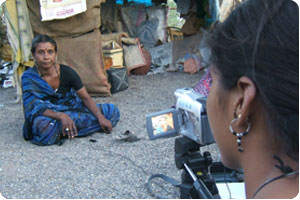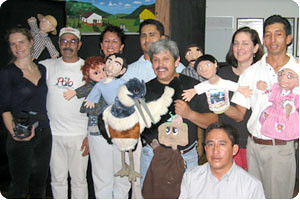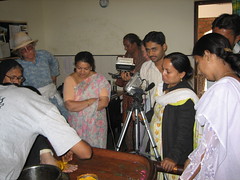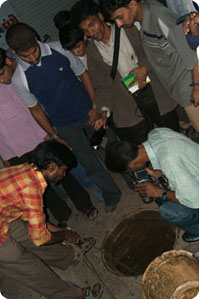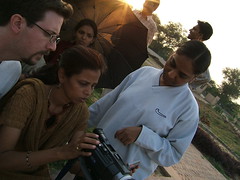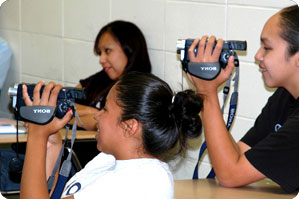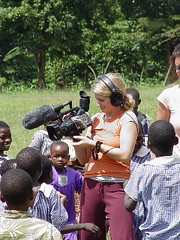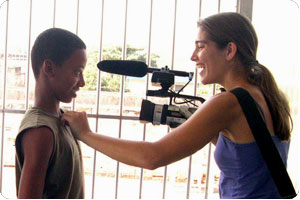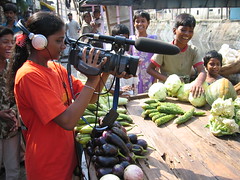Projects
Projects
Video Volunteers undertook many different kinds of ‘media for development’ projects before arriving at the model of the Community Video Unit. Between 2003 and 2005, 17 different NGOs invited us to give them technical assistance on media projects in six different countries, all of which helped us learn how media can be most impactful, sustainable and empowering for communities and organizations.
We trained NGOs in filmmaking and helped to establish NGO Media Units. In these projects, staff of NGOs were trained to produce films for training and advocacy purposes. Most of these Units continue operating today. We also sent volunteer filmmakers to make films for NGOs and advise as “executive producers” to ensure the films would meet the NGOs’ goals. These projects enabled NGOs to access low-cost films for fundraising, and foreign filmmakers to learn how to tell stories about development issues. More than half the volunteers remain involved in Community Media in their current careers. Since all these projects were carried out by passionate and hard-working volunteers (including ourselves), we chose the name Video Volunteers for our organization.
Media Units for Arts and Culture: Bahia, BrazilPartner Organization: Rhythmic Uprising
Bahia is the musical capital of Brazil, and NGOs there use media, dance and music to empower and engage the local youth. Rhythmic Uprising is also producing a feature-length documentary about how a powerful grassroots movement is overcoming social and economic depression, by involving children in performing arts such as drumming, dance, capoeira and circus. Volunteer filmmakers continue to assist on that project. Read more about Rhythmic Uprising. |
Child marriage Community video project: Andhra Pradesh, IndiaPartner Organization: Velugu
|
NGO Media Unit for Women’s Empowerment: Gujarat, IndiaPartner Organization: ANANDI
Activists at ANANDI, an NGO working with rural and tribal women, were trained to produce advocacy and training videos that they screen in village meetings and on local cable systems. Since the 3-month Video Volunteers workshop in 2004 by filmmakers Jen and Lindsay Utz, the Media Unit at ANANDI has produced more than five documentaries on different issues that they screen regularly in the villages. The production team includes a senior ANANDI activist, the organization’s computer operator, and two young women from the community: a young Muslim girl and young Tribal girl. ANANDI has developed an innovative system to market their video magazine (called UMANG VIDEO) through subscriptions and sales to other NGOs. They also screen their films on Indian national television, have created interesting collaborations with local media, and the NGO Directors use them for national and international networking. They used video very effectively during a state-wide, month-long march for Rural Employment, in which the producers made one video every day exposing the lack of services in each of the villages they visited. They screened them nightly on the local cable networks, to rally the support of the town residents for the cause of rural employment. |
Video Training for Environmental Campaigns, Mexico and UKPartner Organization: RARE Conservation
Video Volunteers conducted two intensive video workshops for the DC-based environmental organization Rare Conservation. Rare Conservation develops environmental campaigns geared at local people living in ecologically sensitive areas, in partnership with local environmental activists. The Rare Pride Campaigners are trained in the communications tools of puppetry, street theater, postering and radio. Video Volunteers trained the campaigners in designing video campaigns, and created video modules for their Communications Manual, enabling future Rare Pride Campaigners to use short films to strengthen their campaigns. |
NGO Media Unit for Bhopal Gas Disaster Victims: Bhopal, IndiaPartner Organization: Sambhavna Clinic
Health Workers at The Sambavna Clinic in Bhopal were trained to make educational videos to help people recover from diseases resulting from exposure to toxic gases. Bhopal is the site of the world’s worst industrial disaster, the Union Carbide gas factory explosion in 1984 in which 22,000 people were killed. The Sambhavna Clinic decided they needed to use video to access the harder to reach victims of the disaster in the urban slums of Bhopal. Most of the organization’s health training sessions on issues like TB, which is rampant amongst the victims’ are conducted during the day, which makes it very difficult to reach men who are working. With video, they felt they could reach the men in the evenings at popular outdoor video screenings. |
Wedding Video Training Program: Gujarat, IndiaPartner Organization: Navsarjan Trust
Video Volunteers’ first training was a joint training with two of Drishti’s Gujarat-based partners, Navsjaran and Center for Social Justice. Both of these organizations have since launched Community Video Units. During this workshop, filmmaker volunteers Chandler Griffin and Gabriella Kessler trained Navsarjan workers in video-making, which subsequently led to the creation of a wedding video production school. Navsarjan runs a job training school for young Dalits called Dalit Shakti Kendra, to help them escape from caste-based occupations such as manual scavenging. Thousands of youth have learned trades like tailoring, policing, and cell-phone repair. They now can learn wedding video production. The young people who take the course have generally succeeded in finding employment (either by launching their own business or working for a local videographer) and have raised their incomes substantially. They have realized there is a real need for wedding videographers from the Dalit community. At Dalit weddings, the ‘upper’-caste videographers would not eat with the Dalit wedding party, so the wedding would have to stop while the videographers went elsewhere for a lunch paid for by the wedding-givers, adding extra expense to the whole affair.
A year after the Workshop, Navsarjan sent the four trainees — all young Dalit women working in the organization — to the US to attend a documentary workshop by Barefoot, the media NGO started by their volunteer trainer Chandler Griffin. The young women traveled to Mississippi where they made a film comparing race and caste, perhaps the first ever film to look at American race issues through the lens of caste. |
Human Rights Documentation Unit: Gujarat, IndiaPartner Organization: Center for Social Justice Staff from the Center for Social Justice were also trained in the first Video Volunteers workshop (described above), including the organization’s driver. Center for Social Justice is a human rights organization that, among other things, trains ‘barefoot lawyers’ to prosecute cases against marginalized groups in rural areas, such as atrocities against Dalits, land rights violations, and violence against women. During the workshop, the trainees from Navsarjan and DSK shot footage for a court case of manual scavenging, the illegal caste-based occupation of removing human sewage with their bare hands. The CSJ videographers have continued to produce videos, including a series of video raids exposing the absence of mandatory government services in rural areas; a daily video program of highlights from a ‘games for change’ sporting event, broadcast daily on cable TV; and video testimony from victims of communal rioting in Gujarat. |
Native American Water RightsPartner Organizations: Northern Arapaho Tribal Council and Watershed Resources, Inc.
Video Volunteers produced a film for the Northern Arapaho and Eastern Shoshone Tribes on their water struggle. These two Wyoming Tribes, from the Wind River Reservation, live on the continental divide and have access to the single greatest water right in the continental US. This right was recognized by the US Supreme Court over a decade ago, but the Tribe has never succeeded in developing their water, and continue to live in poverty. The Tribe’s water consultant decided that one of the major things stopping the Tribe from exercising their water was lack of awareness. Because of the negative and anti-Tribal local press, most people thought they had lost the court case, not won. And very few people had any idea as to the financial value of the water. So Video Volunteers produced a film on the water issue, and designed an innovative distribution plan. Every child on the Reservation would take home a copy of the DVD from school, with an assignment to watch the film with their parents. The DVD included a card in which people could vote for what they wanted to do with the water. Did they want to bottle it? Use it only for spiritual use? Use it for recreation and fishing? This was designed to increase people’s participation in Tribal government. The video had one early victory. At the first public screening, the two Tribal governments (who are historically at opposition to each other, and were forced to share a Reservation) came together for the first time in decades and publicly promised to create a joint water board – a critical factor in winning the legal battle. |
AIDS Prevention: Rwanda and UgandaPartner Organization: FXB
Refugee Education: KenyaPartner Organization: FilmAid International FilmAid International uses the power of film to promote health, strengthen communities and enrich the lives of the world’s vulnerable and uprooted. They are producing advocacy videos on the sexual exploitation of refugees, to be screened in refugee camps around Kenya and on Kenyan television. Video Volunteer Brahm Rosensweig assisted in the production of this video. |
Homelessness: New YorkPartner Organization:The Jericho Project
Two New York-based filmmakers, Andrew Ellis and Daniel Gorman, volunteered with The Jericho Project. Jericho Project is a Harlem-based organization that offers long-term housing, job placement, and support to homeless recovering addicts. Their story-based film is aimed at a variety of audiences: funders at annual dinners, but also residents in New York’s homeless shelters whom Jericho hopes to inspire to make changes in their lives. |
Cultural Documentation: BrazilPartner Organization: Viva Favela
The Rio-based organization Viva Favela runs a web-portal and internet cafes targeted at the residents of Rio’s favelas, or slums. The purpose is to link the favelas with the outside world, and to raise awareness amongst middle class Brazilians of life in the Favelas.Video Volunteer Sofia Burstoff traveled to the NGO in February 2003 to help them explore how they can integrate brief video-stories and portraits into their online newspaper. Sofia also produced an outreach video to encourage schools to use the website. |
Blindness prevention: Madurai, IndiaPartner Organization: Aravind Eye Hospital The Aravind Eye Hospital is one of the largest eye-care facilities in the world, having prevented blindness in hundreds of thousands of poor people throughout India. Video Volunteer Aditya Thayi shot a teaching video aimed at eye care professionals working in 170 hospitals worldwide that replicate the Aravind model. The teaching video was designed to instruct hospital managers on how they can improve their outreach into poor communities. |
Fundraising: Mumbai, IndiaPartner Organization: Akanksha
“Aspiration” is a promotional video for Akanksha, a slum children’s education program in Mumbai. The 15-minute video uses portraits of two children to give the viewer a glimpse of life in the slums, and shows how Akanksha transforms children’s lives. Akanksha is using its film in three ways: (i) recruitment – it is shown to teachers interested in volunteering; (ii) fundraising – DVDs are included in mass mailings; and (iii) awareness – in April 2004, it was screened in front of 300 people at a fundraiser in New York. It has also been shown to school children in NYC. |
Advocacy: Assam, IndiaPartner Organization: I-CARD “People of the Flood Plains” is an advocacy video for I-CARD, an NGO that seeks to strengthen the cultural identity of the Mising, one of the poorest and most overlooked Tribes in Assam. The film tells the story of the land struggles of one particular village that exemplify the whole tribe’s experience. It is screened in Mising villages so the community becomes aware of shared problems and can begin to explore solutions. I-CARD was also trained in basic video production: Assamese youth have often turned to terrorism and violence, and I-CARD thought filmmaking could be an alternative form of expression for tribal youth seeking to be heard. I-CARD’s subsequent film projects include recording disappearing traditional dances and a film version of street plays performed by tribal youth on various social problems, enabling the messages to reach a far larger audience. |
Girls’ health and education: Rajasthan, IndiaPartner Organization: Veerni project
The Veerni project brings health and community development services to remote villages in Rajasthan. British filmmaker Bob Edwards worked with the Veerni project to document their work on camera. Rajashtan is one of those most beautiful parts of India, and by capturing the cultural richness in images Veerni hoped to attract funders to this region. |
Training/Empowerment: Gujarat, IndiaPartner Organization: SEWA “Women, Water and Work” was made for one of the most prominent Indian women’s organization, the Self Employed Women’s Association. This film on women-led initiatives to combat drought is being screened frequently in village training sessions to (i) encourage women to join the Water Campaign, (ii) convince women they can do traditionally male tasks, such as hand-pump repair, that the subjects of the video are completing, and (iii) help women visualize the dangers of drought in villages where problems are not yet acute. This film was a participatory video. Co-directors included a former vegetable vendor and a block printer. |


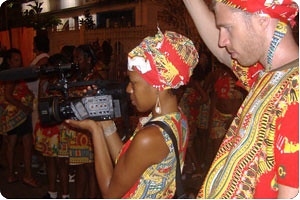 Video Volunteers partnered with Rhythmic Uprising to send volunteer filmmakers to provide media training to four local NGOs in Bahia, Brazil. The local NGOs involved have received cameras and editing computers, as well as training.
Video Volunteers partnered with Rhythmic Uprising to send volunteer filmmakers to provide media training to four local NGOs in Bahia, Brazil. The local NGOs involved have received cameras and editing computers, as well as training.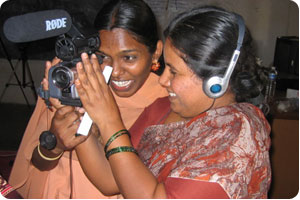 Video Volunteers conducted a video workshop with 11 rural women in South India. During the six-week training, the trainees – all married as children themselves – produced a half hour video on why child marriage must be stopped. The workshop transformed the women from a point where they believed their husbands should be allowed to beat them, to vowing on screen to educate their daughters. The video was screened in local villages, with the Producers and villagers declaring that never before had child marriage or indeed, any other women’s issue been discussed in public. This project, and the intense and successful intellectual training of these rural women, led Video Volunteers and Drishti to the original idea of the Community Video Unit.
Video Volunteers conducted a video workshop with 11 rural women in South India. During the six-week training, the trainees – all married as children themselves – produced a half hour video on why child marriage must be stopped. The workshop transformed the women from a point where they believed their husbands should be allowed to beat them, to vowing on screen to educate their daughters. The video was screened in local villages, with the Producers and villagers declaring that never before had child marriage or indeed, any other women’s issue been discussed in public. This project, and the intense and successful intellectual training of these rural women, led Video Volunteers and Drishti to the original idea of the Community Video Unit. 